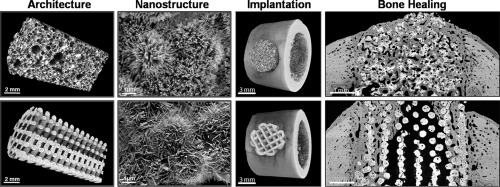Acta Biomaterialia ( IF 9.4 ) Pub Date : 2018-09-06 , DOI: 10.1016/j.actbio.2018.09.003 Albert Barba , Yassine Maazouz , Anna Diez-Escudero , Katrin Rappe , Montserrat Espanol , Edgar B. Montufar , Caroline Öhman-Mägi , Cecilia Persson , Pedro Fontecha , Maria-Cristina Manzanares , Jordi Franch , Maria-Pau Ginebra

|
There is an urgent need of synthetic bone grafts with enhanced osteogenic capacity. This can be achieved by combining biomaterials with exogenous growth factors, which however can have numerous undesired side effects, but also by tuning the intrinsic biomaterial properties. In a previous study, we showed the synergistic effect of nanostructure and pore architecture of biomimetic calcium deficient hydroxyapatite (CDHA) scaffolds in enhancing osteoinduction, i.e. fostering the differentiation of mesenchymal stem cells to bone forming cells. This was demonstrated by assessing bone formation after implanting the scaffolds intramuscularly. The present study goes one step forward, since it analyzes the effect of the geometrical features of the same CDHA scaffolds, obtained either by 3D-printing or by foaming, on the osteogenic potential and resorption behaviour in a bony environment. After 6 and 12 weeks of intraosseous implantation, both bone formation and material degradation had been drastically affected by the macropore architecture of the scaffolds. Whereas nanostructured CDHA was shown to be highly osteoconductive both in the robocast and foamed scaffolds, a superior osteogenic capacity was observed in the foamed scaffolds, which was associated with their higher intrinsic osteoinductive potential. Moreover, they showed a significantly higher cell-mediated degradation than the robocast constructs, with a simultaneous and progressive replacement of the scaffold by new bone. In conclusion, these results demonstrate that the control of macropore architecture is a crucial parameter in the design of synthetic bone grafts, which allows fostering both material degradation and new bone formation.
Statement of Significance
3D-printing technologies open new perspectives for the design of patient-specific bone grafts, since they allow customizing the external shape together with the internal architecture of implants. In this respect, it is important to design the appropriate pore geometry to maximize the bone healing capacity of these implants. The present study analyses the effect of pore architecture of nanostructured hydroxyapatite scaffolds, obtained either by 3D-printing or foaming, on the osteogenic potential and scaffold resorption in an in vivo model. While nanostructured hydroxyapatite showed excellent osteoconductive properties irrespective of pore geometry, we demonstrated that the spherical, concave macropores of foamed scaffolds significantly promoted both material resorption and bone regeneration compared to the 3D-printed scaffolds with orthogonal-patterned struts and therefore prismatic, convex macropores.
中文翻译:

泡沫和3D打印的纳米结构磷酸钙支架的成骨作用:孔结构的影响
迫切需要具有增强成骨能力的合成骨移植物。这可以通过将生物材料与外源性生长因子结合来实现,然而,外源性生长因子可能具有许多不良副作用,而且还可以通过调节生物材料的固有特性来实现。在先前的研究中,我们显示了仿生钙缺乏羟基磷灰石(CDHA)支架的纳米结构和孔结构的协同效应,可增强成骨作用,即促进间充质干细胞向成骨细胞的分化。通过评估肌内植入支架后的骨形成来证明这一点。本研究向前迈出了一步,因为它分析了通过3D打印或发泡获得的相同CDHA支架的几何特征的影响,在骨环境中的成骨潜能和吸收行为。骨内植入6周和12周后,支架的大孔结构极大地影响了骨形成和材料降解。尽管纳米结构的CDHA在机器人支架和泡沫支架中都具有很高的骨传导性,但在泡沫支架中却观察到了优异的成骨能力,这与它们较高的固有骨诱导潜力有关。而且,它们显示出比robocast构建体明显更高的细胞介导的降解,同时用新骨同时逐步进行支架置换。总之,这些结果表明,大孔结构的控制是合成骨移植物设计的关键参数,
重要声明
3D打印技术为患者特定的骨移植设计提供了新的视角,因为它们允许定制外部形状以及植入物的内部结构。在这方面,重要的是设计适当的孔几何形状以使这些植入物的骨愈合能力最大化。本研究分析了通过3D打印或发泡获得的纳米结构羟基磷灰石支架的孔结构对体内成骨潜力和支架吸收的影响模型。尽管纳米结构的羟基磷灰石无论孔的几何形状如何都具有出色的骨传导性能,但我们证明,与具有正交图案的支撑杆的3D打印支架相比,泡沫支架的球形凹形大孔显着促进了材料的吸收和骨再生,因此具有棱柱形的凸形大孔。











































 京公网安备 11010802027423号
京公网安备 11010802027423号